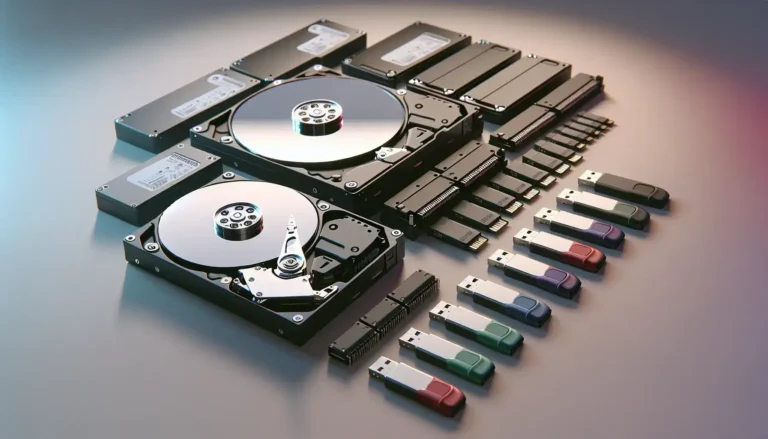In today’s digital world, data storage has become a crucial aspect of both personal and business operations. Whether you’re a small business owner or a part of a large enterprise, understanding the different units of data storage and selecting the right storage solution can significantly impact your efficiency and success. From storing a few files on a local device to managing petabytes of data across servers, having a deep understanding of data storage metrics will help you make informed decisions.
In this guide, we’ll break down the different units of measurement for data storage, from the smallest unit (the bit) to the largest known unit (the yottabyte). We’ll also explore different storage solutions like Direct Attached Storage (DAS), Network Attached Storage (NAS), and Storage Area Networks (SAN), along with their suitability for businesses of varying sizes.
By the end of this article, you’ll have a clearer understanding of what data storage solution is best for your needs, as well as the importance of considering future scalability, security, and costs.
What Are Data Storage Units?
Data storage units are standardized measurements used to quantify the amount of digital information. The smallest unit of data storage is the bit, which is a binary value of either 0 or 1. As you move up the scale, units become exponentially larger. Understanding these units is key to knowing how much storage you need for specific purposes.
Below is a detailed breakdown of data storage units, from the smallest to the largest:
| Unit | Abbreviation | Capacity |
|---|---|---|
| Bit | b | 1 or 0 (on/off) |
| Byte | B | 8 bits |
| Kilobyte | KB | 1024 bytes |
| Megabyte | MB | 1024 kilobytes |
| Gigabyte | GB | 1024 megabytes |
| Terabyte | TB | 1024 gigabytes |
| Petabyte | PB | 1024 terabytes |
| Exabyte | EB | 1024 petabytes |
| Zettabyte | ZB | 1024 exabytes |
| Yottabyte | YB | 1024 zettabytes |
Understanding the Core of Data Storage: Bits and Bytes
Bits: The Building Blocks of Data
At the most basic level, data is stored in the form of bits. A bit is the smallest unit of data, and it represents a binary value, either 0 or 1. These binary values are the foundation upon which all digital data is built. While a single bit may not hold much information, bits are combined into larger units like bytes to store more complex information.
Bytes: The Foundation of Storage
A byte consists of 8 bits and is the smallest unit used to represent a character, whether it’s a letter, number, or symbol. For example, the letter “A” is stored as a specific sequence of bits, and this combination of 8 bits makes up one byte.
Bytes are the standard unit by which data storage is measured, and larger data storage units are multiples of bytes. All memory and storage devices, whether hard drives, USB sticks, or cloud storage services, express their capacity in bytes or its larger counterparts (kilobytes, megabytes, etc.).
Data Storage Units: A Detailed Breakdown
1. Kilobyte (KB)
- 1 KB = 1024 Bytes
Kilobytes were once a common unit of measurement for smaller files, like text documents or small images. Although modern applications have grown significantly in size, understanding kilobytes is still useful for dealing with small-scale data.
2. Megabyte (MB)
- 1 MB = 1024 KB
A megabyte represents about a million bytes, making it suitable for measuring mid-size files such as MP3s or small video clips. For instance, an average MP3 file is around 5 MB, while a high-quality image may take up 3-5 MB of space.
3. Gigabyte (GB)
- 1 GB = 1024 MB
Gigabytes are now the standard measurement unit for data storage in consumer devices. Most smartphones, USB drives, and laptops are sold with gigabytes of storage. To put it in perspective, an HD movie typically takes up around 2-4 GB of space.
4. Terabyte (TB)
- 1 TB = 1024 GB
Terabytes are widely used for larger storage needs, especially in external hard drives and enterprise-level storage solutions. A terabyte can store around 250,000 high-quality MP3 files or over 300 hours of HD video.
5. Petabyte (PB)
- 1 PB = 1024 TB
A petabyte is an astronomical amount of data by consumer standards but is increasingly becoming relevant in the enterprise sector. Companies like Google and Facebook deal with petabytes of data on a daily basis, thanks to the massive amounts of information they handle.
6. Exabyte (EB)
- 1 EB = 1024 PB
At the level of exabytes, data storage is generally reserved for cloud computing giants and massive enterprises. The total global internet traffic per day is estimated to be in the range of exabytes, highlighting just how much data is being produced every second.
7. Zettabyte (ZB)
- 1 ZB = 1024 EB
Zettabytes are used to quantify global data storage on an enormous scale. As more devices become connected through the Internet of Things (IoT), experts predict that we’ll see zettabytes of data being produced annually in the coming decade.
8. Yottabyte (YB)
- 1 YB = 1024 ZB
The yottabyte is the largest recognized unit of data storage, and it is mostly theoretical at this stage. However, with the growth of big data, AI, and machine learning technologies, the need for yottabyte-level storage could become a reality in the future.
What Type of Storage Solution Do You Need?
Now that we’ve covered the units of data storage, let’s explore the different types of storage solutions available based on your specific needs.
1. Direct Attached Storage (DAS)
Best for: Small businesses and individuals
Direct Attached Storage (DAS) is the simplest and most cost-effective form of data storage. This solution involves directly connecting a storage device, such as an external hard drive or USB drive, to your computer or server. Because there’s no network involved, DAS solutions are generally faster and more secure for small-scale data storage needs.
DAS is perfect for small businesses that require basic storage without the need for remote access or file sharing across multiple devices. However, the limitation of DAS lies in its scalability—once you’ve maxed out your storage device, you’ll need to purchase another one, which can become cumbersome as your data grows.
2. Network Attached Storage (NAS)
Best for: Small to mid-sized businesses
Network Attached Storage (NAS) provides a more centralized approach to data storage. Unlike DAS, NAS devices are connected to a network, allowing multiple users to access and share data remotely. NAS units often contain multiple hard drives configured in RAID arrays, offering redundancy and protecting your data from hardware failure.
NAS solutions are great for businesses that need to store a large amount of data, share files between employees, and access data remotely. Additionally, NAS devices can be easily expanded, making them a more scalable option than DAS.
3. Storage Area Network (SAN)
Best for: Large enterprises
For large-scale enterprises, Storage Area Networks (SAN) are the ideal solution. SANs provide high-speed, block-level access to large amounts of data spread across multiple storage devices. These systems are often used in data centers where quick and reliable access to data is critical.
SANs offer high levels of fault tolerance, security, and scalability, making them suitable for businesses with demanding data storage needs. However, the complexity and cost of setting up a SAN make it a solution typically reserved for large companies with dedicated IT resources.
Cloud Storage: The Future of Data Management
As technology evolves, cloud storage has become a popular choice for businesses of all sizes. Cloud storage providers like Amazon Web Services (AWS), Google Cloud, and Microsoft Azure allow companies to store vast amounts of data on remote servers without needing physical storage hardware on-site.
Cloud storage is highly scalable, offering businesses the flexibility to adjust their storage capacity based on their needs. It also reduces the burden of managing physical servers, as data is stored in the cloud and managed by the provider. For companies looking for flexibility, cost-effectiveness, and remote accessibility, cloud storage is a powerful option.
However, cloud storage isn’t without its downsides. Data privacy, security, and compliance issues are concerns that businesses must address when considering cloud storage solutions.
The Future of Data Storage: What Lies Ahead?
The exponential growth of data generation means that even the largest data storage units like zettabytes and yottabytes could become common within the next few decades. The rise of AI, machine learning, and the Internet of Things (IoT) is driving demand for larger and more efficient storage solutions. We are moving towards a world where data storage will be as critical as electricity and water in powering modern industries.
Conclusion
Understanding data storage units and selecting the right storage solution are crucial for both individuals and businesses. As technology continues to advance, so will our need for more complex and larger storage solutions. By staying informed, you’ll be better equipped to handle the challenges of data storage, ensure scalability for your business, and make informed decisions about security, costs, and efficiency.
Whether you’re working with gigabytes, terabytes, or even petabytes of data, having the right storage solution in place will ensure that your data remains accessible, secure, and manageable.

